Byzantium
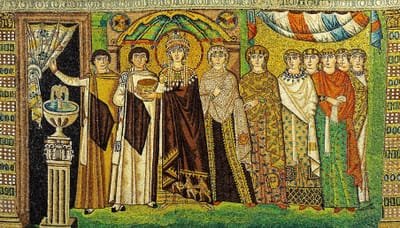
The Byzantine Empire, also referred to as the Eastern Roman Empire or Byzantium, was the continuation of the Roman Empire in its eastern provinces during Late Antiquity and the Middle Ages, when its capital city was Constantinople. It survived the fragmentation and fall of the Western Roman Empire in the 5th century AD and continued to exist for an additional thousand years until the fall of Constantinople to the Ottoman Empire in 1453. During most of its existence, the empire remained the most powerful economic, cultural, and military force in Europe. The terms 'Byzantine Empire' and 'Eastern Roman Empire' were coined after the end of the realm; its citizens continued to refer to their empire simply as the Roman Empire, and to themselves as 'Romans' —a term which Greeks continued to use for themselves into Ottoman times. Although the Roman state continued and its traditions were maintained, modern historians distinguish Byzantium from its earlier incarnation because it was centered on Constantinople, oriented towards Greek rather than Latin culture, and characterised by Eastern Orthodox Christianity.
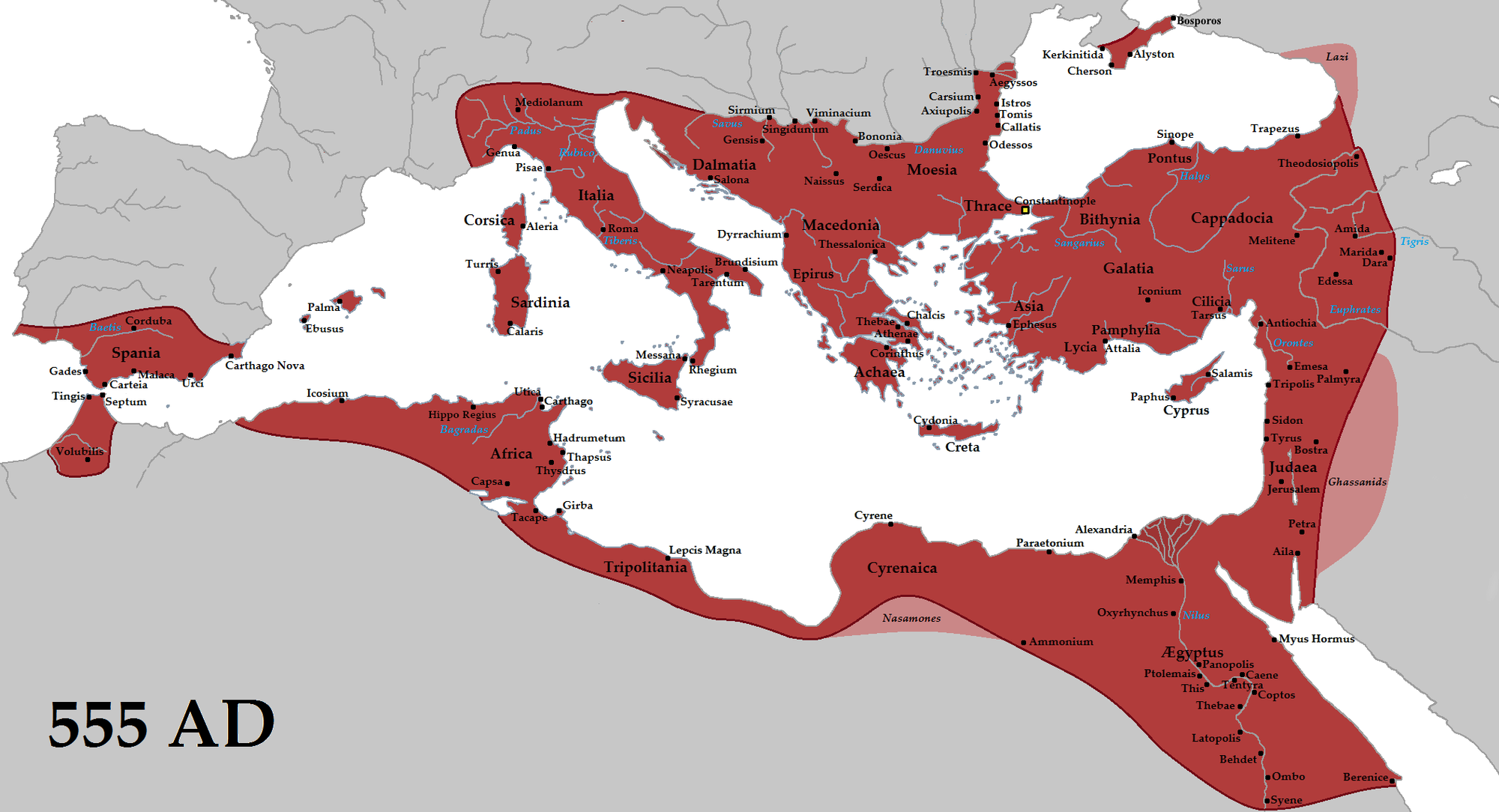 The empire in 555 under Justinian the Great, at its greatest extent since the fall of the Western Roman Empire (its vassals in pink)
The empire in 555 under Justinian the Great, at its greatest extent since the fall of the Western Roman Empire (its vassals in pink)Several events from the 4th to 6th centuries mark the period of transition during which the Roman Empire's Greek East and Latin West diverged. Constantine I (53rd great-granduncle of Raoul Ortiz Lafón r. 324–337) reorganised the empire, made Constantinople the capital and legalised Christianity. Under Theodosius I (53rd great grandfather r. 379–395), Christianity became the state religion, and other religious practices were proscribed. In the reign of Heraclius (44th great-grandfather r. 610–641), the empire's military and administration were restructured, and Greek was gradually adopted for official use in place of Latin. The borders of the empire fluctuated through several cycles of decline and recovery. During the reign of Justinian I (husband of mother-in-law of 1st cousin 48 generations removed r. 527–565), the empire reached its greatest extent after re-conquering much of the historically Roman western Mediterranean coast, including Africa, Italy and Rome, which it held for two more centuries. The Byzantine–Sasanian War of 602–628 exhausted the empire's resources, and during the early Muslim conquests of the 7th century, it lost its richest provinces, Egypt and Syria, to the Rashidun Caliphate. It then lost Africa to the Umayyads in 698, before the empire was rescued by the Isaurian dynasty.
During the Macedonian dynasty (9th–11th centuries), the empire expanded again and experienced the two-century long Macedonian Renaissance, which came to an end with the defeat by Seljuk Turks at the Battle of Manzikert in 1071. Civil wars and the ensuing Seljuk invasion led to the loss of most of Asia Minor. The empire recovered during the Komnenian restoration, and by the 12th century, Constantinople was the largest and wealthiest city in Europe. The empire was delivered a mortal blow during the Fourth Crusade, when Constantinople was sacked in 1204 and the territories that the empire formerly governed were divided into competing Byzantine Greek and Latin realms. Despite the eventual recovery of Constantinople in 1261, the Byzantine Empire remained only one of several small rival states in the area for the final two centuries of its existence. Its remaining territories were progressively annexed by the Ottomans in the Byzantine–Ottoman wars over the 14th and 15th centuries. The fall of Constantinople to the Ottoman Empire in 1453 marked the end of the Byzantine Empire. Refugees fleeing the city after its capture would settle in Italy and other parts of Europe, helping to ignite the Renaissance. The Empire of Trebizond was conquered eight years later, when its eponymous capital surrendered to Ottoman forces after it was besieged in 1461. The last of the Byzantine successor states, the Principality of Theodoro, was conquered by the Ottomans in 1475.
Early history
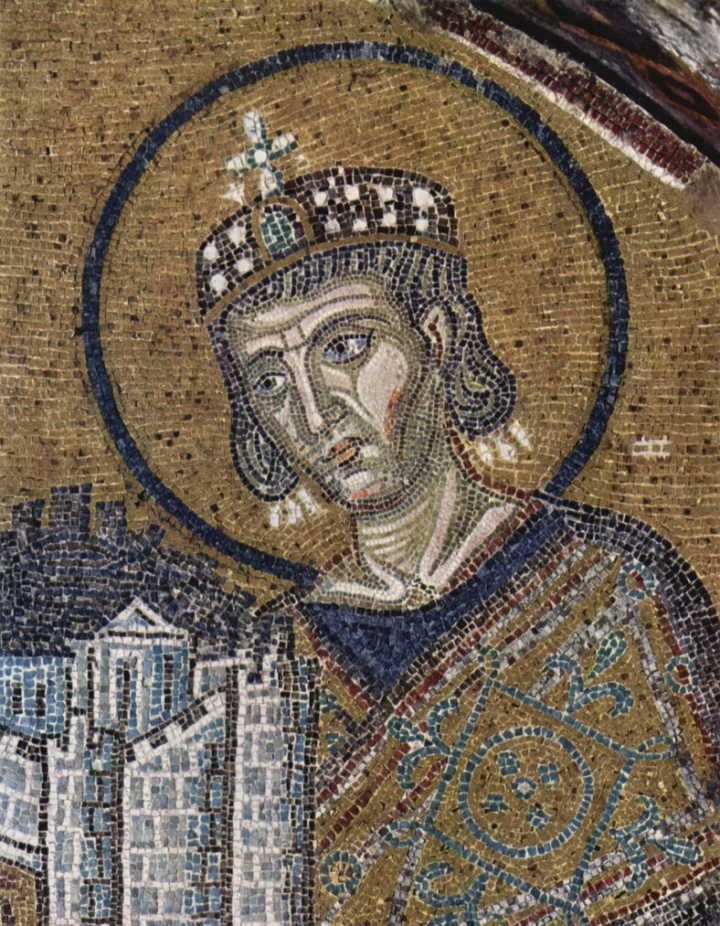 Constantine the Great (53rd great-granduncle) was the first Roman emperor to convert to Christianity and moved the seat of the empire to Byzantium, renamed Constantinople in his honour.
Constantine the Great (53rd great-granduncle) was the first Roman emperor to convert to Christianity and moved the seat of the empire to Byzantium, renamed Constantinople in his honour.By the third century AD, the Roman army had conquered many territories covering the Mediterranean region and coastal regions in southwestern Europe and North Africa. These territories were home to many different cultural groups, both urban populations, and rural populations. Generally speaking, the eastern Mediterranean provinces were more urbanised than the western, having previously been united under the Macedonian Empire and Hellenized by the influence of Greek culture.
The West also suffered more heavily from the instability of the 3rd century. This distinction between the established Hellenized East and the younger Latinized West persisted and became increasingly important in later centuries, leading to a gradual estrangement of the two worlds. An early instance of the partition of the empire into East and West occurred in 286, when Emperor Diocletian (maternal grandfather of wife of 51st great-granduncle) appointed Maximian (husband of 52nd great-grandmother) as Augustus of the West. Just a few years later, in 293, Diocletian created the administrative system known as the Tetrarchy to guarantee security in all endangered regions of his empire. The empire was split into two halves, each ruled by one emperor (augustus). Each co-emperor then appointed a young colleague as caesar to share power and eventually to succeed the senior partner. Each tetrarch was in charge of a part of the empire, with the divisions based on geographic regions. This new system only lasted 20 years, as emperors quickly began fighting each other for power. The whole empire was eventually reunited by Constantine the Great in 324.
Christianisation and partition of the empire
 Restored section of the Walls of Constantinople
Restored section of the Walls of Constantinople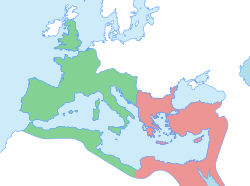 After the death of Theodosius I in 395, the empire was again divided. The west disintegrated in the late 400s while the east ended with the fall of Constantinople in 1453.
After the death of Theodosius I in 395, the empire was again divided. The west disintegrated in the late 400s while the east ended with the fall of Constantinople in 1453. (Green) The Western Roman Empire
(Red)The Eastern Roman/Byzantine Empire
In 330, Constantine moved the seat of the empire to Constantinople, which he founded as a second Rome on the site of Byzantium, a city strategically located on the trade routes between Europe and Asia and between the Mediterranean and the Black Sea. Constantine introduced substantial changes to the empire's military, monetary, civil and religious institutions. In regards to his economic policies he has been accused by certain scholars of "reckless fiscality", but the gold solidus he introduced became a stable currency that transformed the economy and promoted development.
Under Constantine, Christianity did not become the exclusive religion of the state but enjoyed imperial preference since he supported it with generous privileges. Constantine established the principle that emperors could not settle questions of doctrine on their own but should instead summon general ecclesiastical councils for that purpose. His convening of both the Synod of Arles and the First Council of Nicaea indicated his interest in the unity of the Church and showcased his claim to be its head. The rise of Christianity was briefly interrupted on the accession of the emperor Julian (2nd cousin, 51 generations removed) in 361, who made a determined effort to restore polytheism throughout the empire and was thus dubbed "Julian the Apostate" by the Church. However, this was reversed when Julian was killed in battle in 363.
Theodosius I (53rd great-grandfather r. 379–395) was the last emperor to rule both the Eastern and Western halves of the empire. In 391 and 392 he issued a series of edicts essentially banning pagan religion. Pagan festivals and sacrifices were banned, as was access to all pagan temples and places of worship. The last Olympic Games are believed to have been held in 393. In 395, Theodosius I bequeathed the imperial office jointly to his sons: Arcadius in the East and Honorius in the West, once again dividing imperial administration. In the 5th century, the Eastern part of the empire was largely spared the difficulties faced by the West—due in part to a more established urban culture and greater financial resources, which allowed it to placate invaders with tribute and pay foreign mercenaries. This success allowed Theodosius II (51st great-grandfather) to focus on codifying Roman law with the Codex Theodosianus and further fortification of the walls of Constantinople, which left the city impervious to most attacks until 1204.
To fend off the Huns, Theodosius had to pay an enormous annual tribute to Attila (husband of 50th great-grandaunt). His successor, Marcian (husband of 51st great-grandaunt), refused to continue to pay the tribute, but Attila had already diverted his attention to the Western Roman Empire. After Attila's death in 453, the Hun Empire collapsed, and many of the remaining Huns were often hired as mercenaries by Constantinople.
Loss of the Western Roman Empire
After the fall of Attila, the Eastern Empire enjoyed a period of peace, while the Western Empire continued to deteriorate with the expanding migration and invasions of the barbarians, most prominently the Germanic nations. The West's end is usually dated 476 when the East Germanic Roman foederati general Odoacer deposed the Western Emperor Romulus Augustulus, a year after the latter usurped the position from Julius Nepos. In 480 with the death of Nepos, Eastern Emperor Zeno (father-in-law of 45th great-grandmother) became sole claimant to emperor of the empire. Odoacer became King of Italy and was nominally Zeno's subordinate but acted with complete autonomy, eventually providing support to a rebellion against the emperor.
Zeno negotiated with the invading Ostrogoths, who had settled in Moesia, convincing the Gothic king Theodoric (husband of 45th great-grandaunt) to depart for Italy as magister militum per Italiam ("commander in chief for Italy") to depose Odoacer. By urging Theodoric to conquer Italy, Zeno rid the Eastern Empire of an unruly subordinate (Odoacer) and moved another (Theodoric) further from the heart of the empire. After Odoacer's defeat in 493, Theodoric ruled Italy de facto, although he was never recognised by the eastern emperors as "king" (rex).
In 491, Anastasius I (48th great-granduncle), an aged civil officer of Roman origin, became emperor, but it was not until 497 that the forces of Anastasius effectively took the measure of Isaurian resistance. Anastasius revealed himself as an energetic reformer and an able administrator. He introduced a new coinage system of the copper follis, the coin used in most everyday transactions. He also reformed the tax system and permanently abolished the chrysargyron tax. The state treasury contained the enormous sum of 320,000 lb (150,000 kg) of gold when Anastasius died in 518 (roughly worth US$8.3 billion today).
Justinian dynasty
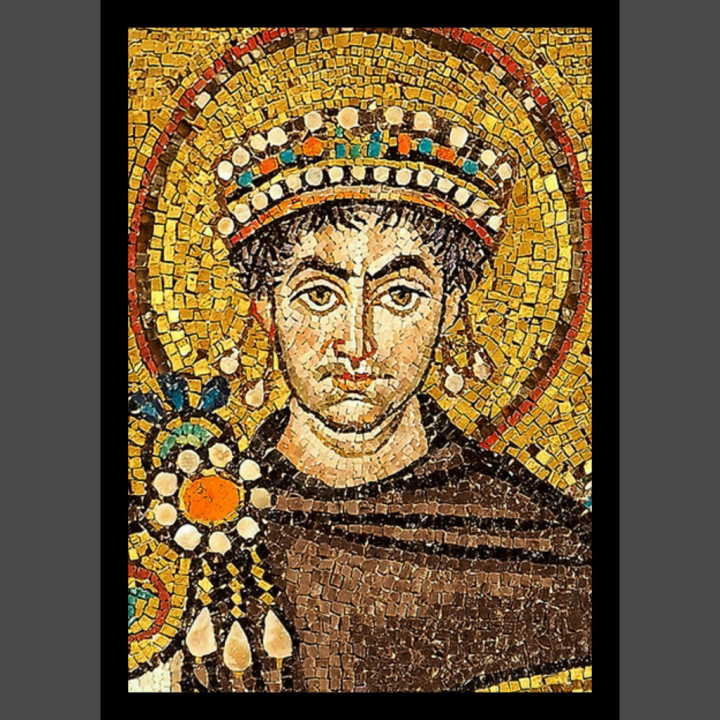 Justinian 'The Great' (husband of Empress Theodora who was mother-in-law of 1st Lafón cousin Anastasius Paulus Probus Sabinianus Pompeius de Byzantium, 48 generations removed).
Justinian 'The Great' (husband of Empress Theodora who was mother-in-law of 1st Lafón cousin Anastasius Paulus Probus Sabinianus Pompeius de Byzantium, 48 generations removed).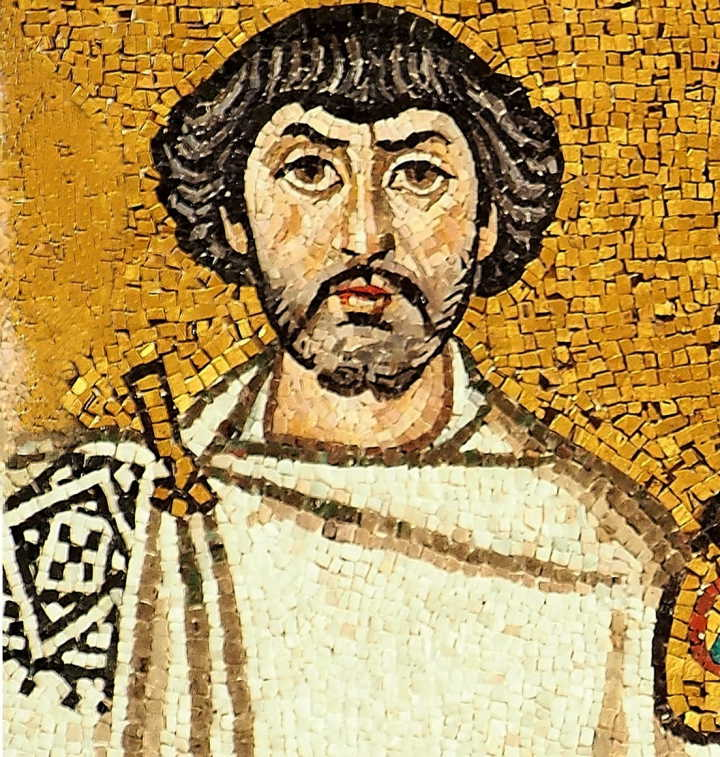 General Flavius Belisarius (father-in-law of 2nd Lafón cousin 47x removed, Flavius Anastasius. Anastasius was the son of Sabinianus Pompeius mentioned above)(Mosaic from Basilica of San Vitale, 6th century).
General Flavius Belisarius (father-in-law of 2nd Lafón cousin 47x removed, Flavius Anastasius. Anastasius was the son of Sabinianus Pompeius mentioned above)(Mosaic from Basilica of San Vitale, 6th century). Empress Theodora (mother-in-law of 1st cousin Sabinianus Pompeius mentioned above) and attendants (Mosaic from Basilica of San Vitale, 6th century).
Empress Theodora (mother-in-law of 1st cousin Sabinianus Pompeius mentioned above) and attendants (Mosaic from Basilica of San Vitale, 6th century).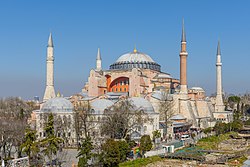 Hagia Sophia built in 537, during the reign of Justinian. The minarets were added in the 15th–16th centuries by the Ottoman Empire.
Hagia Sophia built in 537, during the reign of Justinian. The minarets were added in the 15th–16th centuries by the Ottoman Empire. The Byzantine Empire in c. 600 during the reign of Maurice. Half of the Italian peninsula and most of southern Hispania were lost, but the eastern borders expanded, gaining land from the Persians.
The Byzantine Empire in c. 600 during the reign of Maurice. Half of the Italian peninsula and most of southern Hispania were lost, but the eastern borders expanded, gaining land from the Persians.The Justinian dynasty was founded by Justin I (father-in-law of mother-in-law of 1st cousin 48x removed), who though illiterate, rose through the ranks of the Byzantine army to become emperor in 518. He was succeeded by his nephew Justinian I in 527, who may already have exerted effective control during Justin's reign. One of the most important figures of late antiquity and possibly the last Roman emperor to speak Latin as a first language, Justinian's rule constitutes a distinct epoch, marked by the ambitious but only partly realised renovatio imperii, or "restoration of the empire". Justinian's wife Theodora was particularly influential.
In 529, Justinian appointed a ten-man commission chaired by John the Cappadocian (husband of stepdaughter of 2nd cousin 45x removed) to revise Roman law and create a new codification of laws and jurists' extracts, known as the "Corpus Juris Civilis", or the Justinian Code. In 534, the Corpus was updated and, along with the enactments promulgated by Justinian after 534, formed the system of law used for most of the rest of the Byzantine era. The Corpus forms the basis of civil law of many modern states.
In 532, attempting to secure his eastern frontier, Justinian signed a peace treaty with Khosrau I of Persia (12th cousin, 48 generations removed), agreeing to pay a large annual tribute to the Sassanids. In the same year, he survived a revolt in Constantinople (the Nika riots), which solidified his power but ended with the deaths of a reported 30,000 to 35,000 rioters on his orders. The western conquests began in 533, as Justinian sent his general Belisarius (father-in-law of 2nd Lafón cousin 47x removed) to reclaim the former province of Africa from the Vandals, who had been in control since 429 with their capital at Carthage. Success in the war came with surprising ease, but it was not until 548 that the major local tribes were subdued.
In 535, a small Byzantine expedition to Sicily met with easy success, but the Goths stiffened their resistance, and victory did not come until 540 when Belisarius captured Ravenna, after successful sieges of Naples and Rome. In 535–536, Ostrogoth King Theodahad sent Pope Agapetus I to Constantinople to request the removal of Byzantine forces from Sicily, Dalmatia, and Italy. Although Agapetus failed in his mission to sign a peace with Justinian, he succeeded in having the monophysite Patriarch Anthimus I denounced at the Council of Constantinople, despite Empress Theodora's support and protection.
The Ostrogoths captured Rome in 546. Belisarius, who had been sent back to Italy in 544, was eventually recalled to Constantinople in 549. The arrival of the Armenian eunuch Narses in Italy (late 551) with an army of 35,000 men marked another shift in Gothic fortunes. Ostrogoth King Totila was defeated at the Battle of Taginae, and his successor Teia was defeated at the Battle of Mons Lactarius in October 552. Despite continuing resistance from a few Gothic garrisons and two subsequent invasions by the Franks and Alemanni, the war for the Italian peninsula was at an end. In 551, Athanagild, a noble from Visigothic Hispania, sought Justinian's help in a rebellion against the king, and the emperor dispatched a force under Liberius, a successful military commander. The empire held on to a small slice of the Iberian Peninsula coast until the reign of Heraclius (44th great-grandfather of Ortiz Lafón).
In the east, the Roman–Persian Wars continued until 561 when the envoys of Justinian and Khosrau agreed on a 50-year peace. By the mid-550s, Justinian had won victories in most theatres of operation, with the notable exception of the Balkans, which were subjected to repeated incursions from the Slavs and the Gepids. Tribes of Serbs and Croats were later resettled in the northwestern Balkans, during the reign of Heraclius. Justinian called Belisarius out of retirement and defeated the new Hunnish threat. The strengthening of the Danube fleet caused the Kutrigur Huns to withdraw, and they agreed to a treaty that allowed safe passage back across the Danube.
Although polytheism had been suppressed by the state since at least the time of Theodosius I in the 4th century, traditional Greco-Roman culture was still influential in the Eastern empire in the 6th century. Hellenistic philosophy began to be gradually amalgamated into newer Christian philosophy. Philosophers such as John Philoponus drew on neoplatonic ideas in addition to Christian thought and empiricism. Because of the active paganism of its professors, Justinian closed down the Neoplatonic Academy in 529. Other schools continued in Constantinople, Antioch and Alexandria, which were the centres of Justinian's empire. Hymns written by Romanos the Melodist marked the development of the Divine Liturgy, while the architects Isidore of Miletus and Anthemius of Tralles worked to complete the Church of the Holy Wisdom, Hagia Sophia, which was designed to replace an older church destroyed during the Nika Revolt. Completed in 537, the Hagia Sophia stands today as one of the major monuments of Byzantine architectural history. During the 6th and 7th centuries, the empire was struck by a series of epidemics, which devastated the population and contributed to a significant economic decline and a weakening of the empire. Great bathhouses were built in Byzantine centres such as Constantinople and Antioch.
After Justinian died in 565, his successor, Justin II (brother-in-law of 45th great-grandfather) refused to pay the large tribute to the Persians. Meanwhile, the Germanic Lombards invaded Italy; by the end of the century, only a third of Italy was in Byzantine hands. Justin II's successor, Tiberius II (father-in-law of 3rd cousin, 44x removed), choosing between his enemies, awarded subsidies to the Avars while taking military action against the Persians. Although Tiberius' general, Maurice (father-in-law of 4th cousin, 44x removed), led an effective campaign on the eastern frontier, subsidies failed to restrain the Avars, who captured the Balkan fortress of Sirmium in 582, while the Slavs began to make inroads across the Danube.
Maurice succeeded Tiberius and intervened in a Persian civil war, placing the legitimate Khosrau II (14th cousin, 46 generations removed) back on the throne, and married his daughter Maryam (wife of 14th cousin) to him. Maurice's treaty with his son-in-law enlarged the territories of the empire to the East and allowed the energetic emperor to focus on the Balkans. By 602, a series of successful Byzantine campaigns had pushed the Avars and Slavs back across the Danube. However, Maurice's refusal to ransom several thousand captives taken by the Avars, and his order to the troops to winter in the Danube, caused his popularity to plummet. A revolt broke out under an officer named Phocas, who marched the troops back to Constantinople; Maurice and his family were murdered while trying to escape.
Shrinking borders
Early Heraclian dynasty
 Battle between Heraclius and the Persians. Fresco by Piero della Francesca, c. 1452
Battle between Heraclius and the Persians. Fresco by Piero della Francesca, c. 1452 By 650 (pictured) the empire had lost all its southern provinces, except the Exarchate of Africa, to the Rashidun Caliphate. At the same time the Slavs invaded and settled in the Balkans.
By 650 (pictured) the empire had lost all its southern provinces, except the Exarchate of Africa, to the Rashidun Caliphate. At the same time the Slavs invaded and settled in the Balkans.After Maurice's murder by Phocas, Khosrau used the pretext to reconquer the Roman province of Mesopotamia. Phocas, an unpopular ruler invariably described in Byzantine sources as a "tyrant", was the target of a number of Senate-led plots. He was eventually deposed in 610 by Heraclius, who sailed to Constantinople from Carthage with an icon affixed to the prow of his ship.
Following the accession of Heraclius, the Sassanid advance pushed deep into the Levant, occupying Damascus and Jerusalem and removing the True Cross to Ctesiphon. The counter-attack launched by Heraclius took on the character of a holy war, and an acheiropoieton image of Christ was carried as a military standard (similarly, when Constantinople was saved from a combined Avar–Sassanid–Slavic siege in 626, the victory was attributed to the icons of the Virgin that were led in procession by Patriarch Sergius about the walls of the city). The combined forces unsuccessfully besieged the capital between June and July. After this, the Sassanid army was forced to withdraw to Anatolia. The loss came just after news had reached them of yet another Byzantine victory, where Heraclius's brother Theodore (44th great-granduncle) heavily defeated the Persian general Shahin. Following this, Heraclius led an invasion into Sassanid Mesopotamia once again.
The main Sassanid force was destroyed at Nineveh in 627, and in 629 Heraclius restored the True Cross to Jerusalem in a majestic ceremony, as he marched into the Sassanid capital of Ctesiphon, where anarchy and civil war reigned as a result of the enduring war. Eventually, the Persians were obliged to withdraw all armed forces and return Sassanid-ruled Egypt, the Levant and whatever imperial territories of Mesopotamia and Armenia were in Roman hands at the time of an earlier peace treaty in c. 595. The war had exhausted both the Byzantines and Sassanids, however, and left them extremely vulnerable to the Muslim forces that emerged in the following years. The Byzantines suffered a crushing defeat by the Arabs at the Battle of Yarmouk in 636, while Ctesiphon fell to the Rashidun Caliphate in 637.
First Arab siege of Constantinople (674–678) and the theme system
 Greek fire was first used by the Byzantine Navy during the Byzantine–Arab Wars (from the Madrid Skylitzes, Biblioteca Nacional de España, Madrid).
Greek fire was first used by the Byzantine Navy during the Byzantine–Arab Wars (from the Madrid Skylitzes, Biblioteca Nacional de España, Madrid).The Arabs, firmly in control of Syria and the Levant, sent frequent raiding parties deep into Asia Minor, and in 674–678 laid siege to Constantinople. The Arab fleet was finally repulsed through the use of Greek fire, and a thirty-years' truce was signed between the empire and the Umayyad Caliphate. However, the Anatolian raids continued unabated and accelerated the demise of classical urban culture, with the inhabitants of many cities either refortifying much smaller areas within the old city walls or relocating entirely to nearby fortresses. Constantinople shrank substantially from 500,000 inhabitants to just 40,000–70,000, and, like other urban centres, it was partly ruralised. The city also lost the free grain shipments in 618, after Egypt fell first to the Persians and then to the Arabs, and public wheat distribution ceased.
The void left by the disappearance of the old semi-autonomous civic institutions was filled by the system called theme, which entailed dividing Asia Minor into "provinces" occupied by distinct armies that assumed civil authority and answered directly to the imperial administration. This system may have had its roots in certain ad hoc measures taken by Heraclius, but over the course of the 7th century it developed into an entirely new system of imperial governance. The massive cultural and institutional restructuring of the empire consequent on the loss of territory in the 7th century has been said to have caused a decisive break in east Mediterranean Romanness, and that the Byzantine state is subsequently best understood as another successor state rather than a real continuation of the Roman Empire.
Late Heraclian dynasty
 Constantine IV (41st Lafón great-grandfather) and his retinue, mosaic in Basilica of Sant'Apollinare in Classe. Constantine IV defeated the First Arab siege of Constantinople.
Constantine IV (41st Lafón great-grandfather) and his retinue, mosaic in Basilica of Sant'Apollinare in Classe. Constantine IV defeated the First Arab siege of Constantinople.The withdrawal of large numbers of troops from the Balkans to combat the Persians and then the Arabs in the east opened the door for the gradual southward expansion of Slavic peoples into the peninsula, and, as in Asia Minor, many cities shrank to small fortified settlements. In the 670s, the Bulgars were pushed south of the Danube by the arrival of the Khazars. In 680, Byzantine forces sent to disperse these new settlements were defeated.
In 681, Constantine IV (41st great-grandfather) signed a treaty with the Bulgar Khan Asparukh (40th great-grandfather), and the new Bulgarian state assumed sovereignty over several Slavic tribes that had previously, at least in name, recognized Byzantine rule. In 687–688, the final Heraclian emperor, Justinian II (40th great-grandfather), led an expedition against the Slavs and Bulgarians and made significant gains, although the fact that he had to fight his way from Thrace to Macedonia demonstrates the degree to which Byzantine power in the north Balkans had declined.
Justinian II attempted to break the power of the urban aristocracy through severe taxation and the appointment of "outsiders" to administrative posts. He was driven from power in 695 and took shelter first with the Khazars and then with the Bulgarians. In 705, he returned to Constantinople with the armies of the Bulgarian Khan Tervel (39th great-grandfather), retook the throne and instituted a reign of terror against his enemies. With his final overthrow in 711, supported once more by the urban aristocracy, the Heraclian dynasty came to an end.
Second Arab siege of Constantinople (717–718) and the Isaurian dynasty
 The Byzantine Empire at the accession of Leo III, c. 717. Striped indicates areas raided by the Umayyads.
The Byzantine Empire at the accession of Leo III, c. 717. Striped indicates areas raided by the Umayyads. Gold solidus of Leo III (left), and his son and heir, Constantine V (right)
Gold solidus of Leo III (left), and his son and heir, Constantine V (right)In 717 the Umayyad Caliphate launched a siege on Constantinople which lasted for one year. However, the combination of Leo III the Isaurian's (great-grandfather of husband of 37th great-grandaunt) military genius, the Byzantines' use of Greek fire, a cold winter in 717–718, and Byzantine diplomacy with the Khan Tervel of Bulgaria resulted in a Byzantine victory. After Leo III turned back the Muslim assault in 718, he addressed himself to the task of reorganising and consolidating the themes in Asia Minor. In 740 a major Byzantine victory took place at the Battle of Akroinon where the Byzantines destroyed the Umayyad army.
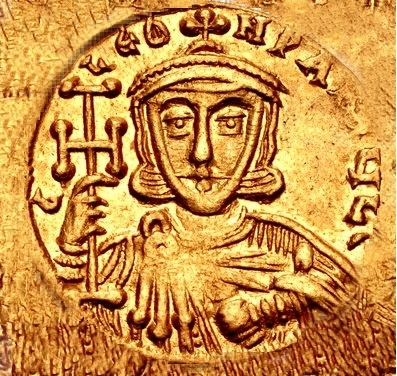 Leo III
Leo III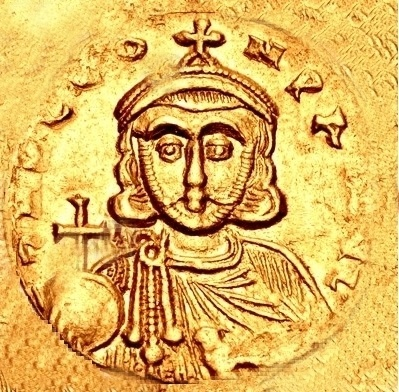 Constantine V
Constantine VConstantine V (paternal grandfather of husband of 35th great-grandaunt) won noteworthy victories in northern Syria and also thoroughly undermined Bulgarian strength. In 746, profiting by the unstable conditions in the Umayyad Caliphate, which was falling apart under Marwan II, Constantine V invaded Syria and captured Germanikeia, and the Battle of Keramaia resulted in a major Byzantine naval victory over the Umayyad fleet. Coupled with military defeats on other fronts of the caliphate and internal instability, Umayyad expansion came to an end.
Religious dispute over iconoclasm
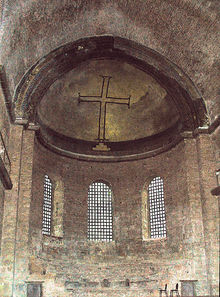 A Simple Cross: An example of Iconoclast art in the Hagia Irene Church in Istanbul.
A Simple Cross: An example of Iconoclast art in the Hagia Irene Church in Istanbul.The 8th and early 9th centuries were also dominated by controversy and religious division over Iconoclasm, which was the main political issue in the empire for over a century. Icons (here meaning all forms of religious imagery) were banned by Leo and Constantine from around 730, leading to revolts by iconodules (supporters of icons) throughout the empire. After the efforts of Empress Irene, the Second Council of Nicaea met in 787 and affirmed that icons could be venerated but not worshipped. Irene (mother-in-law of 35th great-grandaunt) is said to have endeavoured to negotiate a marriage between herself and Charlemagne, but according to Theophanes the Confessor the scheme was frustrated by Aetios, one of her advisors.
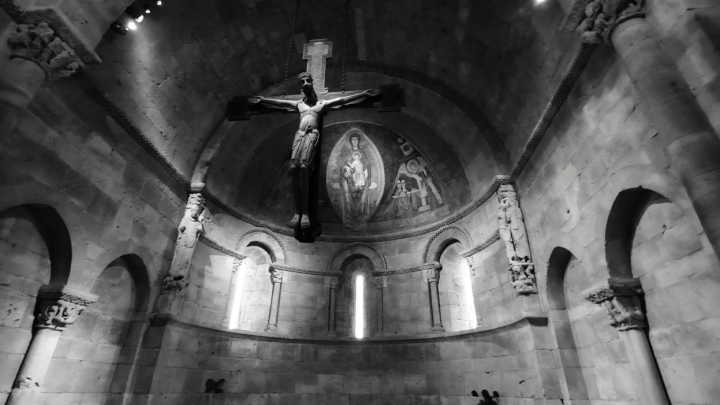 'May we see it with the icons BACK, please.....' (photograph by the author)
'May we see it with the icons BACK, please.....' (photograph by the author)In the early 9th century, Leo V (husband of 37th great-grandaunt) reintroduced the policy of iconoclasm, but in 843 Empress Theodora (34th great-grandmother) restored the veneration of icons with the help of Patriarch Methodios. Iconoclasm played a part in the further alienation of East from West, which worsened during the so-called Photian schism when Pope Nicholas I challenged the elevation of Photios to the patriarchate.
Macedonian dynasty and resurgence (867–1025)
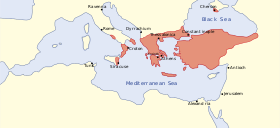 The Byzantine Empire, c. 867
The Byzantine Empire, c. 867The accession of Basil I (33rd great-grandfather) to the throne in 867 marks the beginning of the Macedonian dynasty, which ruled for 150 years. This dynasty included some of the ablest emperors in Byzantium's history, and the period is one of revival. The empire moved from defending against external enemies to reconquest of territories. The Macedonian dynasty was characterised by a cultural revival in spheres such as philosophy and the arts. There was a conscious effort to restore the brilliance of the period before the Slavic and subsequent Arab invasions, and the Macedonian era has been dubbed the "Golden Age" of Byzantium. Although the empire was significantly smaller than during the reign of Justinian I, it had regained much strength, as the remaining territories were less geographically dispersed and more politically, economically, and culturally integrated.
Wars against the Abbasids
 The general Leo Phokas defeats the Hamdanid Emirate of Aleppo at Andrassos in 960, from the Madrid Skylitzes
The general Leo Phokas defeats the Hamdanid Emirate of Aleppo at Andrassos in 960, from the Madrid SkylitzesTaking advantage of the empire's weakness after the Revolt of Thomas the Slav in the early 820s, the Arabs re-emerged and captured Crete. They also successfully attacked Sicily, but in 863 general Petronas gained a decisive victory at the Battle of Lalakaon against Umar al-Aqta, the emir of Melitene (Malatya). Under the leadership of Emperor Krum, the Bulgarian threat also re-emerged, but in 815–816 Krum's son, Omurtag, signed a peace treaty with Leo V.
In the 830s the Abbasid Caliphate started military excursions culminating with a victory in the Sack of Amorium. The Byzantines then counter-attacked and sacked Damietta in Egypt. Later the Abbasid Caliphate responded by sending their troops into Anatolia again, sacking and marauding until they were eventually annihilated by the Byzantines at the Battle of Lalakaon in 863.
In the early years of Basil I's reign, Arab raids on the coasts of Dalmatia and the siege of Ragusa (866–868) were defeated, and the region once again came under secure Byzantine control. This enabled Byzantine missionaries to penetrate to the interior and convert the Serbs and the principalities of modern-day Herzegovina and Montenegro to Christianity.
By contrast, the Byzantine position in Southern Italy was gradually consolidated; by 873 Bari was once again under Byzantine rule, and most of Southern Italy remained in the empire for the next 200 years. On the more important eastern front, the empire rebuilt its defences and went on the offensive. The Paulicians were defeated at the Battle of Bathys Ryax and their capital of Tephrike (Divrigi) taken, while the offensive against the Abbasid Caliphate began with the recapture of Samosata.
 10th century military successes were coupled with a major cultural revival, the so-called Macedonian Renaissance. Miniature from the Paris Psalter, an example of Hellenistic-influenced art.
10th century military successes were coupled with a major cultural revival, the so-called Macedonian Renaissance. Miniature from the Paris Psalter, an example of Hellenistic-influenced art.Under Basil's son and successor, Leo VI the Wise (32nd great-grandfather), the gains in the east against the enfeebled Abbasid Caliphate continued. Sicily was lost to the Arabs in 902, and in 904 Thessaloniki, the empire's second city, was sacked by an Arab fleet. The naval weakness of the empire was rectified. Despite this revenge, the Byzantines were still unable to strike a decisive blow against the Muslims, who inflicted a crushing defeat on the imperial forces when they attempted to regain Crete in 911.
The death of the Bulgarian Emperor Simeon I (father-in-law of niece of wife of 31st great-granduncle) in 927 severely weakened the Bulgarians, allowing the Byzantines to concentrate on the eastern front. Melitene was permanently recaptured in 934, and in 943 the famous general John Kourkouas continued the offensive in Mesopotamia with some noteworthy victories, culminating in the reconquest of Edessa. Kourkouas was especially celebrated for returning to Constantinople the venerated Mandylion, a relic purportedly imprinted with a portrait of Jesus.
The soldier-emperors Nikephoros II Phokas (husband of wife of 1st cousin, 32x removed, r. 963–969) and John I Tzimiskes (husband 1st cousin 32x removed, r. 969–976) expanded the empire well into Syria, defeating the emirs of northwest Iraq. Nikephoros took Aleppo in 962, and the Arabs were decisively expelled from Crete in 963. The recapture of Crete in the siege of Chandax put an end to Arab raids in the Aegean, allowing mainland Greece to flourish again. Cyprus was permanently retaken in 965, and the successes of Nikephoros culminated in 969 with the siege of Antioch and its recapture, which he incorporated as a province of the empire. His successor John Tzimiskes recaptured Damascus, Beirut, Acre, Sidon, Caesarea and Tiberias, putting Byzantine armies within striking distance of Jerusalem, although the Muslim power centres in Iraq and Egypt were left untouched. After much campaigning in the north, the last Arab threat to Byzantium, the rich province of Sicily, was targeted in 1025 by Basil II (2nd cousin, 31 generations removed), who died before the expedition could be completed. By that time the empire stretched from the straits of Messina to the Euphrates and from the Danube to Syria.
Wars against the Bulgarian Empire
Byzantine–Bulgarian wars: Byzantine–Bulgarian war of 894–896, and Byzantine–Bulgarian war of 913–927
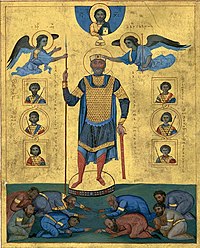 Emperor Basil II 'The Bulgar Slayer' (r. 976–1025) was 2nd cousin of Raoul Ortiz Lafón, 31 generations removed.
Emperor Basil II 'The Bulgar Slayer' (r. 976–1025) was 2nd cousin of Raoul Ortiz Lafón, 31 generations removed.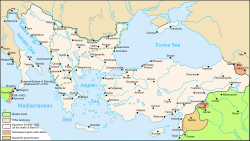 The extent of the Empire under Basil II
The extent of the Empire under Basil IIThe traditional struggle with the See of Rome continued through the Macedonian period, spurred by the question of religious supremacy over the newly Christianised state of Bulgaria. Ending eighty years of peace between the two states, the powerful Bulgarian Tsar Simeon I invaded in 894 but was pushed back by the Byzantines, who used their fleet to sail up the Black Sea to attack the Bulgarian rear, enlisting the support of the Hungarians. The Byzantines were defeated at the Battle of Boulgarophygon in 896, however, and agreed to pay annual subsidies to the Bulgarians.
Leo the Wise died in 912, and hostilities resumed as Simeon marched to Constantinople at the head of a large army. Although the walls of the city were impregnable, the Byzantine administration was in disarray and Simeon was invited into the city, where he was granted the crown of basileus (emperor) of Bulgaria and had the young Emperor Constantine VII (31st great-granduncle) marry one of his daughters (later annulled by Zoe his mother). When a revolt in Constantinople halted his dynastic project, he again invaded Thrace and conquered Adrianople. The empire now faced the problem of a powerful Christian state within a few days' marching distance from Constantinople, as well as having to fight on two fronts.
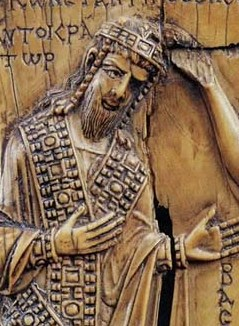 Constantine VII 'Porphyrogenitus', 4th Emperor of the Macedonian Dynasty of Byzantium, Emperor and Autocrat of the Romans (31st great-granduncle of Raoul Ortiz Lafón)
Constantine VII 'Porphyrogenitus', 4th Emperor of the Macedonian Dynasty of Byzantium, Emperor and Autocrat of the Romans (31st great-granduncle of Raoul Ortiz Lafón)A great imperial expedition under Leo Phocas (granduncle of husband of 1st cousin 32x removed) and Romanos I Lekapenos (father-in-law of 31st great-granduncle) ended with another crushing Byzantine defeat at the Battle of Achelous in 917, and the following year the Bulgarians were free to ravage northern Greece. Adrianople was plundered again in 923, and a Bulgarian army laid siege to Constantinople in 924. Simeon died suddenly in 927, however, and Bulgarian power collapsed with him. Bulgaria and Byzantium entered a long period of peaceful relations, and the empire was free to concentrate on the eastern front against the Muslims. In 968, Bulgaria was overrun by the Rus' under Sviatoslav I, but three years later, John I Tzimiskes defeated the Rus' and re-incorporated eastern Bulgaria into the Byzantine Empire.
Bulgarian resistance revived under the rule of the Cometopuli dynasty, but Emperor Basil II (r. 976–1025) made the submission of the Bulgarians his primary goal. Basil's first expedition against Bulgaria, however, resulted in a defeat at the Gates of Trajan. For the next few years, the emperor was preoccupied with internal revolts in Anatolia, while the Bulgarians expanded their realm in the Balkans. The war dragged on for nearly twenty years. The Byzantine victories of Spercheios and Skopje decisively weakened the Bulgarian army, and in annual campaigns Basil methodically reduced the Bulgarian strongholds. At the Battle of Kleidion in 1014 the Bulgarians were annihilated: their army was captured, and it is said that 99 out of every 100 men were blinded, with the hundredth man left with one eye so he could lead his compatriots home. It is told that when Tsar Samuil saw the broken remains of his once formidable army, he went into cardiac arrest brought on by the shock, and died. By 1018, the last Bulgarian strongholds had surrendered, and the country became part of the empire. This victory restored the Danube frontier, which had not been held since the days of the Emperor Heraclius.
Relations with the Kievan Rus'
 Rus' under the walls of Constantinople (860)
Rus' under the walls of Constantinople (860)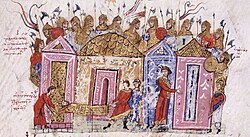 Varangian Guardsmen, an illumination from the Skylitzis Chronicle
Varangian Guardsmen, an illumination from the Skylitzis ChronicleBetween 850 and 1100, the empire developed a mixed relationship with the Kievan Rus', which had emerged to the north across the Black Sea. This relationship had long-lasting repercussions in the history of the East Slavs, and the empire quickly became the main trading and cultural partner for Kiev. The Rus' launched their first attack against Constantinople in 860, pillaging the suburbs of the city. In 941, they appeared on the Asian shore of the Bosphorus, but this time they were crushed, an indication of the improvements in the Byzantine military position after 907, when only diplomacy had been able to push back the invaders. Basil II could not ignore the emerging power of the Rus', and following the example of his predecessors he used religion as a means for achieving political purposes. Rus'–Byzantine relations became closer following the marriage of Anna Porphyrogeneta (2nd cousin 31x removed) to Vladimir the Great in 988, and the subsequent Christianization of the Rus'. Byzantine priests, architects, and artists were invited to work on numerous cathedrals and churches around Rus', expanding Byzantine cultural influence even further, while numerous Rus' served in the Byzantine army as mercenaries, most notably as the famous Varangian Guard.
Even after the Christianisation of the Rus', however, relations were not always friendly. The most serious conflict between the two powers was an invasion of Bulgaria in 968, but several Rus' raiding expeditions against the Byzantine cities of the Black Sea coast and Constantinople are also recorded. Although most were repulsed, they were often followed by treaties that were generally favourable to the Rus', such as the one concluded at the end of the war of 1043, during which the Rus' indicated their ambitions to compete with the Byzantines as an independent power.
Campaigns in the Caucasus
Byzantine–Georgian wars; Byzantine–Seljuk wars.
Between 1021 and 1022, following years of tensions, Basil II led a series of victorious campaigns against the Kingdom of Georgia, resulting in the annexation of several Georgian provinces to the empire. Basil's successors also annexed Bagratid Armenia in 1045. Importantly, both Georgia and Armenia were significantly weakened by the Byzantine administration's policy of heavy taxation and abolishing of the levy. The weakening of Georgia and Armenia played a significant role in the Byzantine defeat at Manzikert in 1071.
Apex
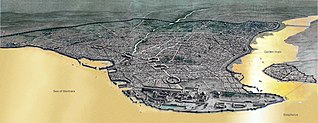 Constantinople was the largest and wealthiest city in Europe throughout late antiquity and most of the Middle Ages until the Fourth Crusade in 1204.
Constantinople was the largest and wealthiest city in Europe throughout late antiquity and most of the Middle Ages until the Fourth Crusade in 1204.Basil II is considered among the most capable Byzantine emperors and his reign as the apex of the empire in the Middle Ages. By 1025, the date of Basil II's death, the Byzantine Empire stretched from Armenia in the east to Calabria in southern Italy in the west. Many successes had been achieved, ranging from the conquest of Bulgaria to the annexation of parts of Georgia and Armenia, and the reconquests of Crete, Cyprus, and the important city of Antioch. These were not temporary tactical gains but long-term reconquests.
Leo VI (32nd great grandfather) achieved the complete codification of Byzantine law in Greek. This monumental work of 60 volumes became the foundation of all subsequent Byzantine law and is still studied today. Leo also reformed the administration of the empire, redrawing the borders of the administrative subdivisions (the themata, or "themes") and tidying up the system of ranks and privileges, as well as regulating the behaviour of the various trade guilds in Constantinople. Leo's reform did much to reduce the previous fragmentation of the empire, which henceforth had one centre of power, Constantinople. However, the increasing military success of the empire greatly enriched and gave the provincial nobility more power over the peasantry, who were essentially reduced to a state of serfdom.
Under the Macedonian emperors Constantinople flourished, becoming the largest and wealthiest city in Europe, with a population of approximately 400,000 in the 9th and 10th centuries. During this period, the Byzantine Empire employed a strong civil service staffed by competent aristocrats that oversaw the collection of taxes, domestic administration, and foreign policy. The Macedonian emperors also increased the empire's wealth by fostering trade with Western Europe, particularly through the sale of silk and metalwork.
Split between Orthodoxy and Catholicism (1054)
 Mural of Saints Cyril and Methodius, 19th century, Troyan Monastery, Bulgaria
Mural of Saints Cyril and Methodius, 19th century, Troyan Monastery, BulgariaThe Macedonian period included events of momentous religious significance. The conversion of the Bulgarians, Serbs and Rus' to Orthodox Christianity drew the religious map of Europe which still resonates today. Cyril and Methodius, two Byzantine Greek brothers from Thessaloniki, contributed significantly to the Christianisation of the Slavs and in the process devised the Glagolitic alphabet, ancestor to the Cyrillic script.
In 1054, relations between the Eastern and Western traditions of the Chalcedonian Christian Church reached a terminal crisis. Although there was a formal declaration of institutional separation on 16 July, when three papal legates entered the Hagia Sophia during Divine Liturgy on a Saturday afternoon and placed a bull of excommunication on the altar, the so-called Great Schism was actually the culmination of centuries of gradual separation.
Crisis and fragmentation
The Byzantine Empire fell into a period of difficulties, caused to a large extent by the undermining of the theme system and the neglect of the military. Nikephoros II, John Tzimiskes, and Basil II shifted the emphasis of the military divisions (τάγματα, tagmata) from a reactive, defence-oriented citizen army into an army of professional career soldiers, increasingly dependent on foreign mercenaries. Mercenaries were expensive, however, and as the threat of invasion receded in the 10th century, so did the need for maintaining large garrisons and expensive fortifications. Basil II left a burgeoning treasury upon his death, but he neglected to plan for his succession. None of his immediate successors had any particular military or political talent, and the imperial administration increasingly fell into the hands of the civil service. Incompetent efforts to revive the Byzantine economy resulted in severe inflation and a debased gold currency. The army was seen as both an unnecessary expense and a political threat. A number of standing local units were demobilised, further augmenting the army's dependence on mercenaries, who could be retained and dismissed on an as-needed basis.
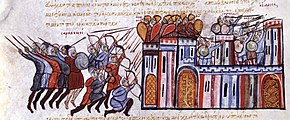 The seizure of Edessa (1031) by the Byzantines under George Maniakes and the counterattack by the Seljuk Turks
The seizure of Edessa (1031) by the Byzantines under George Maniakes and the counterattack by the Seljuk TurksAt the same time, Byzantium was faced with new enemies. Its provinces in southern Italy were threatened by the Normans who arrived in Italy at the beginning of the 11th century. During a period of strife between Constantinople and Rome culminating in the East-West Schism of 1054, the Normans advanced slowly but steadily into Byzantine Italy. Reggio, the capital of the tagma of Calabria, was captured in 1060 by Robert Guiscard (26th great-grandfather), followed by Otranto in 1068. Bari, the main Byzantine stronghold in Apulia, was besieged in August 1068 and fell in April 1071.
About 1053, Constantine IX (husband of 3rd cousin, 30x removed) disbanded what the historian John Skylitzes calls the "Iberian Army", which consisted of 50,000 men, and it was turned into a contemporary Drungary of the Watch. Two other knowledgeable contemporaries, the former officials Michael Attaleiates and Kekaumenos, agree with Skylitzes that by demobilising these soldiers Constantine did catastrophic harm to the empire's eastern defences. The emergency lent weight to the military aristocracy in Anatolia, who in 1068 secured the election of one of their own, Romanos Diogenes (grandnephew of husband of 3rd cousin 32x removed), as emperor. In the summer of 1071, Romanos undertook a massive eastern campaign to draw the Seljuks into a general engagement with the Byzantine army. At the Battle of Manzikert, Romanos suffered a surprise defeat by Sultan Alp Arslan and was captured. Alp Arslan treated him with respect and imposed no harsh terms on the Byzantines. In Constantinople, however, a coup put in power Michael Doukas (stepson of grandnephew of husband of 3rd cousin 30x removed) who soon faced the opposition of Nikephoros Bryennios (father-in-law of wife of step-grandson of grandnephew of husband of 3rd cousin 30x removed) and Nikephoros III Botaneiates (husband of wife of stepson of grandnephew of husband of 3rd cousin 30x removed). By 1081, the Seljuks had expanded their rule over virtually the entire Anatolian plateau from Armenia in the east to Bithynia in the west, and they had founded their capital at Nicaea, just 90 kilometres (56 miles) from Constantinople.
Komnenian dynasty and the Crusades
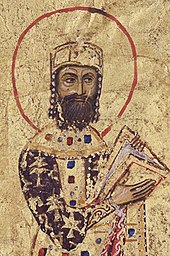 Alexios I, founder of the Komnenos dynasty
Alexios I, founder of the Komnenos dynastyAfter Manzikert, a partial recovery (referred to as the Komnenian restoration) was made possible by the Komnenian dynasty. During the Komnenian period from about 1081 to about 1185, the dynasty presided over a sustained, though ultimately incomplete, restoration of the military, territorial, economic, and political position of the Byzantine Empire. Although the Seljuk Turks occupied the heartland of the empire in Anatolia, most Byzantine military efforts during this period were directed against Western powers, particularly the Normans.
The empire under the Komnenoi played a key role in the history of the Crusades in the Holy Land, which Alexios I had helped bring about, while also exerting enormous cultural and political influence in Europe, the Near East, and the lands around the Mediterranean Sea under John and Manuel. Contact between Byzantium and the "Latin" West, including the Crusader states, increased significantly during the Komnenian period. Venetian and other Italian traders became resident in large numbers in Constantinople and the empire (there were an estimated 60,000 Latins in Constantinople alone, out of a population of three to four hundred thousand), and their presence together with the numerous Latin mercenaries who were employed by Manuel helped to spread Byzantine technology, art, literature and culture throughout the Latin West, while also leading to a flow of Western ideas and customs into the empire.
Alexios I and the First Crusade
 The Chora Church, dating from the Komnenian period, has some of the finest Byzantine frescoes and mosaics.
The Chora Church, dating from the Komnenian period, has some of the finest Byzantine frescoes and mosaics.The Komnenoi attained power under Alexios I in 1081. From the outset of his reign, Alexios faced a formidable attack by the Normans under Guiscard and his son Bohemund of Taranto (25th great-granduncle), who captured Dyrrhachium and Corfu and laid siege to Larissa in Thessaly. Guiscard's death in 1085 temporarily eased the Norman problem. The following year, the Seljuq sultan died, and the sultanate was split by internal rivalries. By his own efforts, Alexios defeated the Pechenegs, who were caught by surprise and annihilated at the Battle of Levounion on 28 April 1091.
 The Byzantine Empire and the Seljuk Sultanate of Rûm before the First Crusade (1095–1099)
The Byzantine Empire and the Seljuk Sultanate of Rûm before the First Crusade (1095–1099)Having achieved stability in the West, Alexios could turn his attention to the severe economic difficulties and the disintegration of the empire's traditional defences. However, he still did not have enough manpower to recover the lost territories in Asia Minor and to advance against the Seljuks. At the Council of Piacenza in 1095, envoys from Alexios spoke to Pope Urban II about the suffering of the Christians of the East and underscored that without help from the West they would continue to suffer under Muslim rule. Urban saw Alexios's request as a dual opportunity to cement Western Europe and reunite the Eastern Orthodox Church with the Roman Catholic Church under his rule. On 27 November 1095, Urban called the Council of Clermont and urged all those present to take up arms under the sign of the Cross and launch an armed pilgrimage to recover Jerusalem and the East from the Muslims. The response in Western Europe was overwhelming.
Alexios had anticipated help in the form of mercenary forces from the West, but he was totally unprepared for the immense and undisciplined force that arrived in Byzantine territory. It was no comfort to Alexios to learn that four of the eight leaders of the main body of the Crusade were Normans, among them Bohemund. Since the crusade had to pass through Constantinople, however, the emperor had some control over it. He required its leaders to swear to restore to the empire any towns or territories they might reconquer from the Turks on their way to the Holy Land. In return, he gave them guides and a military escort. Alexios was able to recover a number of important cities, islands and much of western Asia Minor. The Crusaders agreed to become Alexios' vassals under the Treaty of Devol in 1108, which marked the end of the Norman threat during Alexios' reign.
John II, Manuel I and the Second Crusade
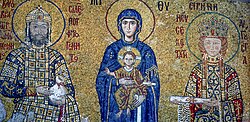 A mosaic from the Hagia Sophia of Constantinople (modern Istanbul), depicting Mary and Jesus, flanked by John II Komnenos (left) and his wife Irene of Hungary (right), 12th century
A mosaic from the Hagia Sophia of Constantinople (modern Istanbul), depicting Mary and Jesus, flanked by John II Komnenos (left) and his wife Irene of Hungary (right), 12th century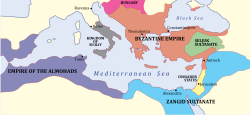 Byzantine Empire in orange, c. 1180, at the end of the Komnenian period
Byzantine Empire in orange, c. 1180, at the end of the Komnenian periodAlexios's son John II Komnenos succeeded him in 1118 and ruled until 1143. John was a pious and dedicated emperor who was determined to undo the damage to the empire suffered at the Battle of Manzikert half a century earlier. Famed for his piety and his remarkably mild and just reign, John was an exceptional example of a moral ruler at a time when cruelty was the norm. For this reason, he has been called the Byzantine Marcus Aurelius. During his twenty-five-year reign, John made alliances with the Holy Roman Empire in the West and decisively defeated the Pechenegs at the Battle of Beroia. He thwarted Hungarian and Serbian threats during the 1120s, and in 1130 he allied himself with German Emperor Lothair III against Norman King Roger II of Sicily.
In the later part of his reign, John focused his activities on the East, personally leading numerous campaigns against the Turks in Asia Minor. His campaigns fundamentally altered the balance of power in the East, forcing the Turks onto the defensive, while restoring many towns, fortresses, and cities across the peninsula to the Byzantines. He defeated the Danishmend Emirate of Melitene and reconquered all of Cilicia, while forcing Raymond of Poitiers, Prince of Antioch, to recognise Byzantine suzerainty. In an effort to demonstrate the emperor's role as the leader of the Christian world, John marched into the Holy Land at the head of the combined forces of the empire and the Crusader states; yet despite his great vigour pressing the campaign, his hopes were disappointed by the treachery of his Crusader allies. In 1142, John returned to press his claims to Antioch, but he died in the spring of 1143 following a hunting accident.
John's chosen heir was his fourth son, Manuel I Komnenos, who campaigned aggressively against his neighbours both in the west and in the east. In Palestine, Manuel allied with the Crusader Kingdom of Jerusalem and sent a large fleet to participate in a combined invasion of Fatimid Egypt. Manuel reinforced his position as overlord of the Crusader states, with his hegemony over Antioch and Jerusalem secured by agreement with Raynald, Prince of Antioch, and Amalric of Jerusalem. In an effort to restore Byzantine control over the ports of southern Italy, he sent an expedition to Italy in 1155, but disputes within the coalition led to the eventual failure of the campaign. Despite this military setback, Manuel's armies successfully invaded the southern parts of the Kingdom of Hungary in 1167, defeating the Hungarians at the Battle of Sirmium. By 1168, nearly the whole of the eastern Adriatic coast lay in Manuel's hands. Manuel made several alliances with the pope and Western Christian kingdoms, and he successfully handled the passage of the crusaders through his empire.
In the East, however, Manuel suffered a major defeat in 1176 at the Battle of Myriokephalon against the Turks. Yet the losses were quickly recovered, and in the following year Manuel's forces inflicted a defeat upon a force of "picked Turks". The Byzantine commander John Vatatzes, who destroyed the Turkish invaders at the Battle of Hyelion and Leimocheir, brought troops from the capital and was able to gather an army along the way, a sign that the Byzantine army remained strong and that the defensive programme of western Asia Minor was still successful.
12th-century Renaissance
 The Lamentation of Christ (1164), a fresco from the church of Saint Panteleimon in Nerezi, North Macedonia, considered a superb example of 12th-century Komnenian art
The Lamentation of Christ (1164), a fresco from the church of Saint Panteleimon in Nerezi, North Macedonia, considered a superb example of 12th-century Komnenian artJohn and Manuel pursued active military policies, and both deployed considerable resources on sieges and city defences; aggressive fortification policies were at the heart of their imperial military policies. Despite the defeat at Myriokephalon, the policies of Alexios, John and Manuel resulted in vast territorial gains, increased frontier stability in Asia Minor, and secured the stabilisation of the empire's European frontiers. From c. 1081 to c. 1180, the Komnenian army assured the empire's security, enabling Byzantine civilisation to flourish.
This allowed the Western provinces to achieve an economic revival that continued until the close of the century. It has been argued that Byzantium under the Komnenian rule was more prosperous than at any time since the Persian invasions of the 7th century. During the 12th century, population levels rose and extensive tracts of new agricultural land were brought into production. Archaeological evidence from both Europe and Asia Minor shows a considerable increase in the size of urban settlements, together with a notable upsurge in new towns. Trade was also flourishing; the Venetians, the Genoese and others opened up the ports of the Aegean to commerce, shipping goods from the Crusader states and Fatimid Egypt to the west and trading with the empire via Constantinople.
In artistic terms, there was a revival in mosaic, and regional schools of architecture began producing many distinctive styles that drew on a range of cultural influences. During the 12th century, the Byzantines provided their model of early humanism as a renaissance of interest in classical authors. In Eustathius of Thessalonica, Byzantine humanism found its most characteristic expression. In philosophy, there was a resurgence of classical learning not seen since the 7th century, characterised by a significant increase in the publication of commentaries on classical works. Besides, the first transmission of classical Greek knowledge to the West occurred during the Komnenian period. In terms of prosperity and cultural life, the Komnenian period was one of the peaks in Byzantine history, and Constantinople remained the leading city of the Christian world in size, wealth, and culture. There was a renewed interest in classical Greek philosophy, as well as an increase in literary output in vernacular Greek. Byzantine art and literature held a pre-eminent place in Europe, and the cultural impact of Byzantine art on the West during this period was enormous and of long-lasting significance.
Decline and disintegration
Angelid dynasty
 Byzantium in the late Angeloi period
Byzantium in the late Angeloi periodManuel's death on 24 September 1180 left his 11-year-old son Alexios II Komnenos on the throne. Alexios was highly incompetent in the office, and with his mother Maria of Antioch's Frankish background, his regency was unpopular. Eventually, Andronikos I Komnenos, a grandson of Alexios I, launched a revolt against his younger relative and managed to overthrow him in a violent coup d'état. Utilising his good looks and his immense popularity with the army, Andronikos marched to Constantinople in August 1182 and incited a massacre of the Latins. After eliminating his potential rivals, he had himself crowned as co-emperor in September 1183. He eliminated Alexios II and took his 12-year-old wife Agnes of France for himself.
Andronikos began his reign well; in particular, the measures he took to reform the government of the empire have been praised by historians. According to George Ostrogorsky, Andronikos was determined to root out corruption: under his rule, the sale of offices ceased; selection was based on merit, rather than favouritism; officials were paid an adequate salary to reduce the temptation of bribery. In the provinces, Andronikos's reforms produced a speedy and marked improvement. The aristocrats were infuriated against him, and to make matters worse, Andronikos seems to have become increasingly unbalanced; executions and violence became increasingly common, and his reign turned into a reign of terror. Andronikos seemed almost to seek the extermination of the aristocracy as a whole. The struggle against the aristocracy turned into wholesale slaughter, while the emperor resorted to ever more ruthless measures to shore up his regime.
Despite his military background, Andronikos failed to deal with Isaac Komnenos, Béla III of Hungary who reincorporated Croatian territories into Hungary, and Stephen Nemanja of Serbia who declared his independence from the Byzantine Empire. Yet, none of these troubles would compare to William II of Sicily's invasion force of 300 ships and 80,000 men, arriving in 1185 and sacking Thessalonica. Andronikos mobilised a small fleet of 100 ships to defend the capital, but other than that he was indifferent to the populace. He was finally overthrown when Isaac II Angelos, surviving an imperial assassination attempt, seized power with the aid of the people and had Andronikos killed.
The reign of Isaac II, and more so that of his brother Alexios III, saw the collapse of what remained of the centralised machinery of Byzantine government and defence. Although the Normans were driven out of Greece, in 1186 the Vlachs and Bulgars began a rebellion that led to the formation of the Second Bulgarian Empire. The internal policy of the Angeloi was characterised by the squandering of the public treasure and fiscal maladministration. Imperial authority was severely weakened, and the growing power vacuum at the centre of the empire encouraged fragmentation. There is evidence that some Komnenian heirs had set up a semi-independent state in Trebizond before 1204. According to Alexander Vasiliev, "the dynasty of the Angeloi, Greek in its origin, ... accelerated the ruin of the Empire, already weakened without and disunited within."
Fourth Crusade
 The Entry of the Crusaders into Constantinople, by Eugène Delacroix (1840)
The Entry of the Crusaders into Constantinople, by Eugène Delacroix (1840)In 1198, Pope Innocent III broached the subject of a new crusade through legates and encyclical letters. The stated intent of the crusade was to conquer Egypt, the centre of Muslim power in the Levant. The crusader army arrived at Venice in the summer of 1202 and hired the Venetian fleet to transport them to Egypt. As a payment to the Venetians, they captured the (Christian) port of Zara in Dalmatia (vassal city of Venice, which had rebelled and placed itself under Hungary's protection in 1186). Shortly afterwards, Alexios IV Angelos, son of the deposed and blinded Emperor Isaac II, made contacts with the crusaders. Alexios offered to reunite the Byzantine church with Rome, pay the crusaders 200,000 silver marks, join the crusade, and provide all the supplies they needed to reach Egypt.
Crusader sack of Constantinople (1204)
 The partition of the empire following the Fourth Crusade, c. 1204
The partition of the empire following the Fourth Crusade, c. 1204The crusaders arrived at Constantinople in the summer of 1203 and quickly attacked, starting a major fire that damaged large parts of the city, and briefly seized control. Alexios III fled from the capital, and Alexios Angelos was elevated to the throne as Alexios IV along with his blind father Isaac. Alexios IV and Isaac II were unable to keep their promises and were deposed by Alexios V. The crusaders again took the city on 13 April 1204, and Constantinople was subjected to pillage and massacre by the rank and file for three days. Many priceless icons, relics and other objects later turned up in Western Europe, a large number in Venice. According to chronicler Niketas Choniates, a prostitute was even set up on the patriarchal throne. When order had been restored, the crusaders and the Venetians proceeded to implement their agreement; Baldwin of Flanders was elected emperor of a new Latin Empire, and the Venetian Thomas Morosini was chosen as patriarch. The lands divided up among the leaders included most of the former Byzantine possessions. Although Venice was more interested in commerce than conquering territory, it took key areas of Constantinople, and the Doge took the title of "Lord of a Quarter and Half a Quarter of the Roman Empire".
Empire in exile
Further information: Frankokratia
After the sack of Constantinople in 1204 by Latin crusaders, two Byzantine successor states were established: the Empire of Nicaea and the Despotate of Epirus. A third, the Empire of Trebizond, was created after Alexios Komnenos, commanding the Georgian expedition in Chaldia a few weeks before the sack of Constantinople, found himself de facto emperor and established himself in Trebizond. Of the three successor states, Epirus and Nicaea stood the best chance of reclaiming Constantinople. The Nicaean Empire struggled to survive the next few decades, however, and by the mid-13th century it had lost much of southern Anatolia. The weakening of the Sultanate of Rûm following the Mongol invasion in 1242–1243 allowed many beyliks and ghazis to set up their own principalities in Anatolia, weakening the Byzantine hold on Asia Minor. In time, one of the Beys, Osman I, created the Ottoman Empire that would eventually conquer Constantinople. However, the Mongol invasion also gave Nicaea a temporary respite from Seljuk attacks, allowing it to concentrate on the Latin Empire to its north.
Reconquest of Constantinople
 The Byzantine Empire, c. 1263
The Byzantine Empire, c. 1263The Empire of Nicaea, founded by the Laskarid dynasty, managed to effect the recapture of Constantinople from the Latins in 1261 and defeat Epirus. This led to a short-lived revival of Byzantine fortunes under Michael VIII Palaiologos, but the war-ravaged empire was ill-equipped to deal with the enemies that surrounded it. To maintain his campaigns against the Latins, Michael pulled troops from Asia Minor and levied crippling taxes on the peasantry, causing much resentment. Massive construction projects were completed in Constantinople to repair the damage of the Fourth Crusade, but none of these initiatives was of any comfort to the farmers in Asia Minor suffering raids from Muslim ghazis.
Rather than holding on to his possessions in Asia Minor, Michael chose to expand the empire, gaining only short-term success. To avoid another sacking of the capital by the Latins, he forced the Church to submit to Rome, again a temporary solution for which the peasantry hated Michael and Constantinople. The efforts of Andronikos II and later his grandson Andronikos III marked Byzantium's last genuine attempts in restoring the glory of the empire. However, the use of mercenaries by Andronikos II often backfired, with the Catalan Company ravaging the countryside and increasing resentment towards Constantinople.
Rise of the Ottomans and fall of Constantinople
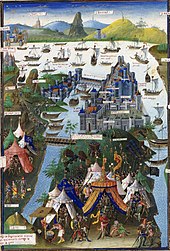 The siege of Constantinople in 1453, depicted in a 15th-century French miniature
The siege of Constantinople in 1453, depicted in a 15th-century French miniatureThe situation became worse for Byzantium during the civil wars after Andronikos III died. A six-year-long civil war devastated the empire, allowing the Serbian ruler Stefan Dušan to overrun most of the empire's remaining territory and establish a Serbian Empire. In 1354, an earthquake at Gallipoli devastated the fort, allowing the Ottomans (who were hired as mercenaries during the civil war by John VI Kantakouzenos) to establish themselves in Europe. By the time the Byzantine civil wars had ended, the Ottomans had defeated the Serbians and subjugated them as vassals. Following the Battle of Kosovo, much of the Balkans became dominated by the Ottomans.
The Byzantine emperors appealed to the West for help, but the pope would only consider sending aid in return for a reunion of the Eastern Orthodox Church with the See of Rome. Church unity was considered and occasionally accomplished by imperial decree, but the Orthodox citizenry and clergy intensely resented the authority of Rome and the Latin Rite. Some Western troops arrived to bolster the Christian defence of Constantinople, but most Western rulers, distracted by their own affairs, did nothing as the Ottomans picked apart the remaining Byzantine territories.
Constantinople by this stage was underpopulated and dilapidated. The population of the city had collapsed so severely that it was now little more than a cluster of villages separated by fields. On 2 April 1453, Sultan Mehmed's army of 80,000 men and large numbers of irregulars laid siege to the city. Despite a desperate last-ditch defence of the city by the massively outnumbered Christian forces (c. 7,000 men, 2,000 of whom were foreign), Constantinople finally fell to the Ottomans after a two-month siege on 29 May 1453. The final Byzantine emperor, Constantine XI Palaiologos, was last seen casting off his imperial regalia and throwing himself into hand-to-hand combat after the walls of the city were taken.
Political aftermath
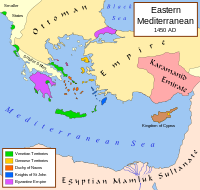 The Eastern Mediterranean just before the Fall of Constantinople
The Eastern Mediterranean just before the Fall of Constantinople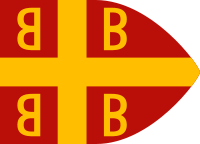 Flag of the late Empire under the Palaiologoi, sporting the tetragrammic cross symbol of the Palaiologos dynasty
Flag of the late Empire under the Palaiologoi, sporting the tetragrammic cross symbol of the Palaiologos dynastyBy the time of the fall of Constantinople, the Byzantine Empire, already an empire in name only since the Fourth Crusade, had been reduced to three rump states, which were the Despotate of the Morea, the Empire of Trebizond and the Principality of Theodoro. The Morea was ruled by the brothers of Constantine XI, Thomas Palaiologos and Demetrios Palaiologos. The despotate continued as an independent state by paying an annual tribute to the Ottomans. Incompetent rule, failure to pay the annual tribute, and a revolt against the Ottomans finally led to Mehmed II's invasion of Morea in May 1460.
A few holdouts remained for a time. The island of Monemvasia refused to surrender, and it was ruled for a short time by an Aragonese corsair. When the population drove him out they obtained the consent of Thomas to place themselves under the pope's protection before the end of 1460. The Mani Peninsula, on the Morea's south end, resisted under a loose coalition of the local clans and then that area came under Venice's rule. The last holdout was Salmeniko, in the Morea's northwest. Graitzas Palaiologos was the military commander there, stationed at Salmeniko Castle. While the town eventually surrendered, Graitzas and his garrison and some town residents held out in the castle until July 1461, when they escaped and reached Venetian territory.
The Empire of Trebizond, which had split away from the Byzantine Empire just weeks before Constantinople was taken by the Crusaders in 1204, became the last remnant and last de facto successor state to the Byzantine Empire. Efforts by Emperor David to recruit European powers for an anti-Ottoman crusade provoked war between the Ottomans and Trebizond in the summer of 1461. After a month-long siege, David surrendered the city of Trebizond on 14 August 1461. Trebizond's Crimean principality, the Principality of Theodoro (part of the Perateia), lasted another 14 years, falling to the Ottomans in December 1475. Therefore, the last remnant of the Roman Empire had officially ceased to exist, after 2,228 years of Roman civilization, since the legendary Founding of Rome in 753 BC.
A nephew of the last emperor, Constantine XI, Andreas Palaiologos claimed to have inherited the title of Byzantine emperor. He lived in the Morea until its fall in 1460, then escaped to Rome where he lived under the protection of the Papal States for the remainder of his life. Since the office of the emperor had never been technically hereditary, Andreas' claim would have been without merit under Byzantine law. However, the empire had vanished, and Western states generally followed the Roman-church-sanctioned principles of hereditary sovereignty. Seeking a life in the west, Andreas styled himself Imperator Constantinopolitanus ("Emperor of Constantinople"), and sold his succession rights to both Charles VIII of France and the Catholic Monarchs.
Constantine XI died without producing an heir, and had Constantinople not fallen he might have been succeeded by the sons of his deceased elder brother, who were taken into the palace service of Mehmed II after the fall of Constantinople. The oldest boy, renamed Has Murad, became a personal favorite of Mehmed and served as beylerbey (governor-general) of the Balkans. The younger son, renamed Mesih Pasha, became admiral of the Ottoman fleet and sanjak-bey (governor) of the Province of Gallipoli. He eventually served twice as grand vizier under Mehmed's son, Bayezid II.
Mehmed II and his successors continued to consider themselves heirs to the Roman Empire. They considered that they had simply shifted their religious basis as Constantine had done before, and they continued to refer to their conquered Eastern Roman inhabitants (Orthodox Christians) as Rûm. However, this claim gradually faded away, as the Ottoman Empire assumed a more Islamic political identity. Meanwhile, the Danubian Principalities (whose rulers also considered themselves the heirs of the Eastern Roman Emperors) harbored Orthodox refugees, including some Byzantine nobles.
At Constantine's death, the role of the emperor as a patron of Eastern Orthodoxy was claimed by Ivan III, Grand Prince of Muscovy. He had married Andreas' sister, Sophia Palaiologina, whose grandson, Ivan IV, would become the first tsar of Russia (tsar, or czar, meaning caesar, is a term traditionally applied by Slavs to the Byzantine emperors). Their successors supported the idea that Moscow was the proper heir to Rome and Constantinople. The idea of the Russian Empire as the successive Third Rome was kept alive until its demise with the Russian Revolution.